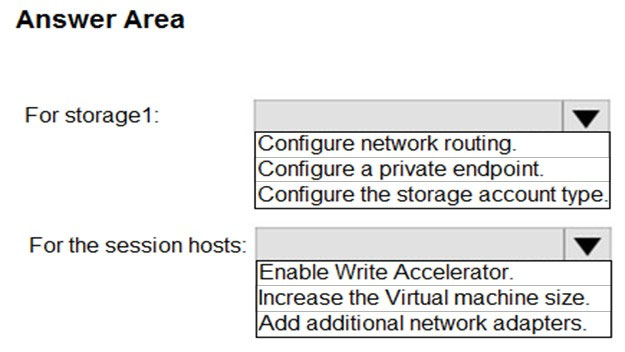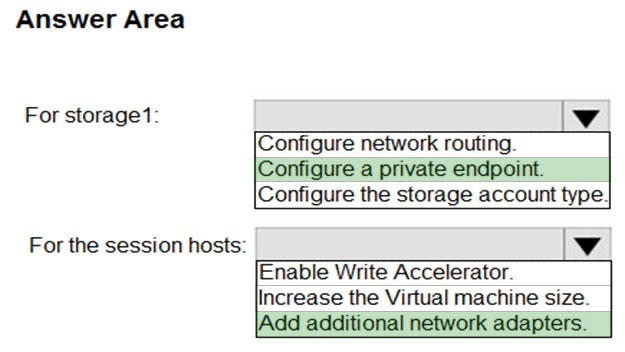You have an Azure Virtual Desktop host pool that contains 20 Windows 10 Enterprise multi-session hosts.
Users connect to the Azure Virtual Desktop deployment from computers that run Windows 10.
You plan to implement FSLogix Application Masking.
You need to deploy Application Masking rule sets. The solution must minimize administrative effort.
To where should you copy the rule sets?
C
Reference:
https://docs.microsoft.com/en-us/azure/virtual-desktop/fslogix-office-app-rule-editor
Your network contains an on-premises Active Directory domain and an Azure Virtual Desktop deployment. The computer accounts for all the session hosts are in an organizational unit (OU) named WVDHostsOU. All user accounts are in an OU named CorpUsers.
A domain administrator creates a Group Policy Object (GPO) named Policy1 that only contains user settings. The administrator links Policy1 to WVDHostsOU.
You discover that when users sign in to the session hosts, none of the settings from Policy1 are applied.
What should you configure to apply GPO settings to the users when they sign in to the session hosts?
A
Reference:
https://www.linkedin.com/pulse/windows-virtual-desktop-remoteapps-jason-byway
You have an Azure Virtual Desktop deployment.
You need to provide external users with access to the deployment. The external users have computers that run Windows 10 Pro and Windows 10 Enterprise. The users do not have the ability to install applications.
What should you recommend that the users use to connect to the deployment?
A
Reference:
https://docs.microsoft.com/en-us/azure/active-directory/governance/entitlement-management-external-users https://docs.microsoft.com/en-us/azure/virtual-desktop/connect-web
You network contains an on-premises Active Directory domain. The domain contains a universal security group named AVDusers.
You have a hybrid Azure Active Directory (Azure AD) tenant. AVDusers syncs to Azure AD.
You have an Azure Virtual Desktop host pool that contains four Windows 10 Enterprise multi-session hosts.
You need to ensure that only the members of AVDusers can establish Azure Virtual Desktop sessions to the host pool.
What should you do?
D
Reference:
https://docs.microsoft.com/en-us/azure/virtual-desktop/manage-app-groups
You deploy multiple Azure Virtual Desktop session hosts that have only private IP addresses.
You need to ensure that administrators can initiate an RDP session to the session hosts by using the Azure portal.
What should you implement?
C
Azure Bastion is a new fully platform-managed PaaS service you provision inside your virtual network. It provides secure and seamless RDP/SSH connectivity to your VMs directly in the Azure portal over SSL. When you connect via Azure Bastion, your virtual machines do not need a public IP address.
Reference:
https://azure.microsoft.com/en-us/services/azure-bastion/
You have an Azure Virtual Desktop host pool named Pool1. Pool1 contains session hosts that have a third-party application named App1. App1 is published by using a RemoteApp group.
A new MSI-based version of App1 is installed each month to each host. The name of the executable file is different for each version of App1.
You need to automate the process of making a new version of App1 available via RemoteApp. The process must ensure that the user experience remains the same when launching the application from the Windows Desktop client.
Which two cmdlets should you run? Each correct answer presents part of the solution.
NOTE: Each correct selection is worth one point.
BD
Reference:
https://docs.microsoft.com/en-us/azure/virtual-desktop/what-is-app-attach https://docs.microsoft.com/en-us/powershell/module/az.desktopvirtualization/new-azwvdapplication?view=azps-6.4.0
You have an Azure Virtual Desktop deployment.
You need to recommend a solution to run containerized applications without installing the applications on the session hosts.
What should you include in the recommendation?
D
Reference:
https://docs.microsoft.com/en-us/windows/msix/msix-container
HOTSPOT -
You have an Azure Virtual Desktop host pool named Pool1 and an Azure Storage account named storage1. Pool1 and storage1 are in the same Azure region.
The current network utilization of the session hosts during peak hours is 95%.
You plan to use FSLogix profile containers stored in storage1 for users that connect to Pool1.
You need to configure the session hosts and storage1 to minimize network latency when loading and updating profiles.
What should you do? To answer, select the appropriate options in the answer area.
NOTE: Each correct selection is worth one point.
Hot Area:

Reference:
https://docs.microsoft.com/en-us/azure/architecture/example-scenario/wvd/windows-virtual-desktop-fslogix
You have an Azure Virtual Desktop host pool named Pool1 that contains three session hosts. The session hosts are configured to use FSLogix profiles.
On a management computer, you create an Application Masking rule and assignment files.
You need to apply Application Masking to the session hosts in Pool1.
What should you do?
D
Reference:
https://cloudbuild.co.uk/fslogix-application-masking-in-windows-virtual-desktop/
You have an Azure Virtual Desktop deployment.
The session hosts are joined to an on-premises Active Directory domain named contoso.com.
You need to limit user sessions to three hours.
What should you configure?
A